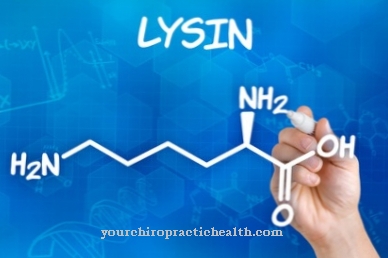The Ribonucleic Acid Synthesis is a prerequisite for protein synthesis. The ribonucleic acids transfer the genetic information from the DNA to the proteins. In some viruses, ribonucleic acids even represent the entire genome.
What is ribonucleic acid synthesis?

Ribonucleic acid synthesis always takes place on the DNA. There, complementary ribonucleotides are assembled into an RNA strand using an enzymatically controlled process. Ribonucleic acid (RNA) has a similar structure to deoxyribonucleic acid (DNA). It consists of nucleobases, a sugar residue and phosphates. When put together, the three building blocks form a nucleotide. The sugar consists of a ribose. It's a pentose with five carbon atoms. The difference to DNA is that the sugar in the 2-position in the pentose ring contains a hydroxyl group instead of a hydrogen atom.
The ribose is esterified with phosphoric acid in two places. This creates a chain with alternating ribose and phosphate units. A nucleobase is glycosidically bound to the side of the ribose. Four different nucleobases are available to build up the RNA. These are the pyrimidine bases cytosine and uracil and the purine bases adenine and guanine.
The nitrogen base thymine is found in the DNA instead of uracil. Three nucleotides in a row each form a triplet which codes for an amino acid. The code is determined by the order of the nucleic bases (nitrogen bases). In contrast to DNA, RNA is single-stranded. This is caused by the hydroxyl group at the 2-position of the ribose.
Function & task
In ribonucleic acid synthesis, different types of RNA are synthesized. In contrast to DNA, RNA is not used for long-term storage of genetic information, but for its transmission.
The messenger RNA (mRNA) is responsible for this. It copies the genetic information from DNA and passes it on to the ribosome, where protein synthesis takes place. The information is only temporarily stored in the RNA. After the protein synthesis has ended, it is broken down again.
The tRNA and the rRNA do not carry any genetic information, but rather help to build proteins on the ribosome. Other ribonucleic acids are responsible for gene expression. They are therefore responsible for which genetic information should be read at all. They thus also contribute to the differentiation of the cells. Finally, there is RNA that even takes on catalytic functions.
Some viruses contain only RNA instead of DNA. This means that their genetic code is stored in the RNA. However, RNA can only be synthesized using DNA. Viruses are therefore only ever able to live and multiply within a host cell.
In ribonucleic acid synthesis, the enzyme RNA polymerase catalyzes the formation of RNA on the DNA, which results in the exact transfer of the genetic code. The transcription is initiated by binding the RNA polymerase to a promoter. This is a specific nucleotide sequence on DNA. In a short stretch of DNA, the double helix is broken up by breaking the hydrogen bond. In the process, complementary ribonucleotides are attached to the corresponding bases on the codogenic strand of the DNA.
Ribose and phosphate groups combine to form an ester bond, creating the strand of RNA. The DNA is only opened at a short section. The section of the RNA strand that has already been synthesized protrudes from this opening. The ribonucleic acid synthesis ends at an area of the DNA called a terminator. There is a stop code there. When the stop code is reached, the RNA polymerase detaches itself from the DNA and the RNA that is formed is released.
Illnesses & ailments
Ribonucleic acid synthesis is a fundamental process, so a disruption has devastating consequences for the organism. In order to be able to synthesize proteins, there must be no major deviations in the synthesis. However, some foreign RNA particles can reprogram the entire cell so that the body cell only synthesizes foreign RNA. This process is common and plays a big role in viral infections.
Viruses cannot multiply on their own. You are always dependent on a host cell. There are both DNA viruses and pure RNA viruses. Both types penetrate the cell and incorporate their genetic material into the genetic code of the host cell. The cell starts to replicate only the genetic material of the virus. The cell produces viruses until it dies. The newly formed viruses penetrate further cells and continue their work of destruction.
The RNA viruses build their genetic material into the DNA with the help of the enzyme reverse transcriptase. After the integration, the synthesis of viral RNA dominates, which is then returned to the next cell. The retroviruses also belong to the RNA viruses. A well-known retrovirus is the HI virus. Retroviruses, however, are a special case. Although they also incorporate their genetic material into the DNA via reverse transcriptase, the new viruses that are created leave the cell without destroying it. This allows infected cells to become a constant source of viruses.
In the production of new viruses, however, mutations also constantly occur, which permanently change the virus. The immune system does indeed form antibodies against the existing viruses, but before these are destroyed, the genetic code has changed so much that antibodies once formed are no longer effective. The body has to keep producing new antibodies. The immune system is so stressed that it permanently loses its resistance to bacteria, fungi and viruses.
























.jpg)



